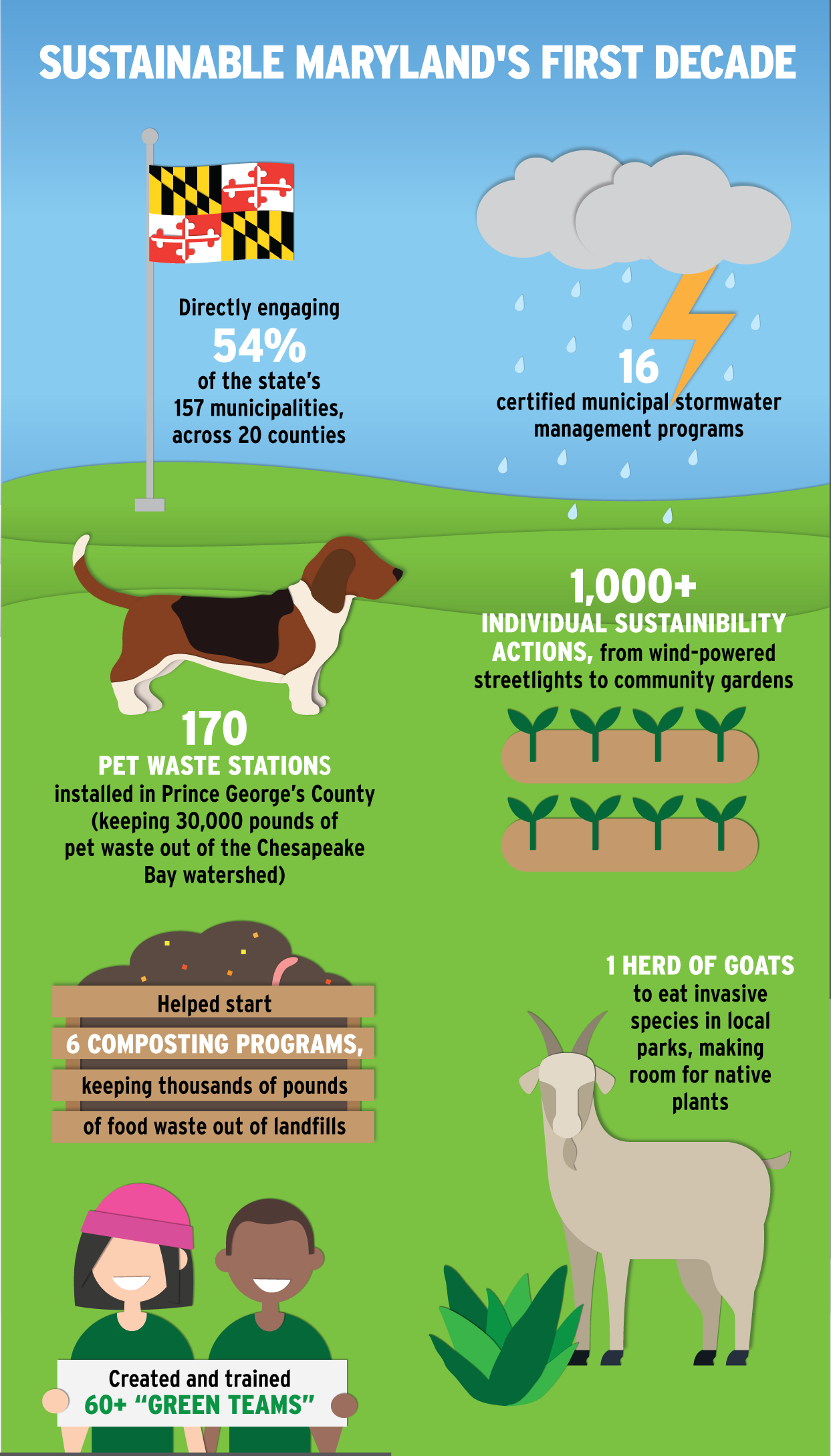Gaze across the sprawling field of solar panels just west of Annapolis, and it’s hard to imagine that just underneath lies 80 acres of trash. Annapolis Solar Park is the largest solar project built on a capped landfill in the United States, cutting the city’s electric bill more than $100,000 a year—and for Annapolis, it is part of a larger effort to create a greener, healthier community.
The city has had help. Annapolis is one of 85 municipalities and homeowner’s associations across the state enrolled in Sustainable Maryland (SM), a no-cost “greening” program from the University of Maryland’s Environmental Finance Center. Now marking its 10th anniversary, SM has mobilized sustainability efforts from New Carrollton to North Beach by connecting municipalities with funding opportunities, training, expertise and a tight-knit network of peer communities.
“Avenues to execute sustainability projects, like launching a farmer’s market or promoting a local business district, are essential for economic stability and quality of life in local communities,” said Sustainable Maryland Program Manager Mike Hunninghake. “Racial inequity and climate change bring additional challenges to municipalities that are already under-resourced; many just don’t have the funding or expertise to tackle a flooding issue or create a tree canopy program. What we try and do is bridge that gap, by providing assistance and access to opportunity.”
Sustainable Maryland currently engages 54% of all Maryland municipalities—including the state’s 10 most populous cities—across 20 counties. In Prince George’s County alone, SM works with 26 of the 27 municipalities. The program guides local stakeholders in developing individual, tailored sustainability plans that prioritize green initiatives and pinpoint where best to funnel resources. With over 100 greening actions for communities to choose from, SM is a “choose your own adventure” in sustainability that equates to big numbers for Maryland—shrinking carbon footprints, protecting waterways and building resilient, healthier places to live.
“Sustainability has become a way of life for us, and having Sustainable Maryland help us develop a plan each year keeps us on track,” said Rod Barnes, town administrator for Edmonston, Maryland. Edmonston has leveraged SM’s guidance, training and network to develop $4.2 million in successful grants, funding 28 rain gardens, three public fruit orchards, a pet waste program and more.
Membership in the program has its privileges: SM’s network connects local stakeholders with funding opportunities and workshops, as well as faculty and student assistance for a variety of technical projects, from creating a carbon reduction blueprint to conducting an energy audit. The rapidly-growing network of municipalities is a hub for inspiration and best practices; when Landover Hills wanted to create a composting and food waste collection program, SM connected the town’s mayor, Jeff Schomisch, with Berwyn Heights, who had successfully launched a similar program.
“Mike and his team have connected us with other communities to build off what’s already been done, so we’re not reinventing the wheel,” said Schomisch. “There are a lot of towns that are in the same boat as us. We all want to make our communities better places to live.”
Modeled after the Sustainable New Jersey program, Sustainable Maryland was a collaboration between the EFC, the Maryland Municipal League and UMD’s National Center for Smart Growth in 2011 to share applied technical assistance and cost-effective strategies with Maryland communities looking to launch small- and large-scale sustainability initiatives. Sustainable Maryland currently does not receive any state funding, relying on grants and support from partners like the Maryland Municipal League.
Residents play a big part in creating the goals for certification, but also in setting those plans into motion. Amanda Dewey, mayor of Berwyn Heights, who started her service to the town as a member of Berwyn Heights’ Green Team, says that the program has provided a framework for bringing people together and the resources to make the town’s goals a reality, particularly for staff-strapped government offices.
“Staff capacity for small towns—and there are so many in Maryland—is so limited,” she said. “So, if we want to look at tree canopy issues or put together a carbon footprint report, we can draw on the professional expertise at the University of Maryland.”
Sustainability actions culminate in certification and a ceremony; the program currently boasts 45 certified municipalities. But for most, it is just the beginning. Since its inception, SM has had 36 municipalities certify more than once.
“You can bet that if there is trash in one of the raingardens, I’m getting a call,” said Barnes. “Our residents see the results these projects bring to the community and it’s a real point of pride.”
“Composting, LED lighting, rain gardens; it all adds up,” said Hunninghake. “It’s not just one town working alone, it’s all of these towns working to make Maryland more sustainable and to have a collective impact on the planet. And, over 10 years, those numbers are significant.”
Here’s what 10 years of greening Maryland looks like, by the numbers:

